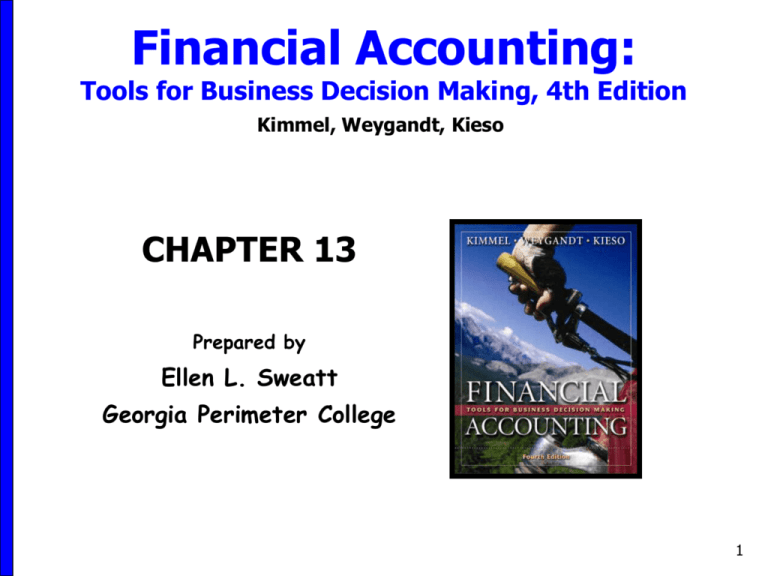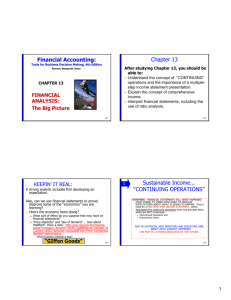
Financial Accounting:
Tools for Business Decision Making, 4th Edition
Kimmel, Weygandt, Kieso
CHAPTER 13
Prepared by
Ellen L. Sweatt
Georgia Perimeter College
1
Chapter 13
FINANCIAL ANALYSIS:
The Big Picture
2
Chapter 13
After studying Chapter 13, you should be
able to:
Understand the concept of sustainable
income.
Indicate how irregular items are presented.
Explain the concept of comprehensive
income.
Describe and apply horizontal analysis.
Describe and apply vertical analysis.
3
Chapter 13
After studying Chapter 13, you should be
able to:
Identify and compute ratios used in analyzing
a company’s liquidity, solvency, and
profitability.
Understand the concept of quality of earnings.
4
Sustainable Income...
1
11
Is the most likely level of income to be
obtained in the future.
Does not include irregular revenues,
expenses, gains, or losses.
5
Components of the Income
Statement
6
2
11
Irregular Items
Two types of irregular items are
reported -- (all net of taxes)
discontinued operations
extraordinary items
7
Discontinued Operations...
Refers to the disposal of a significant
segment of a business...
the elimination of a major class of
customers or
an entire activity.
8
Discontinued Operations
Rozek net income of $800,000 from continuing
operations in 2007.
During 2007 the company discontinued and sold its
unprofitable chemical division. The loss in 2007 from
chemical operations (net of $90,000 taxes) was
$210,000. The tax rate is 30%.
9
Extraordinary Items...
Are events and
transactions that
meet two
conditions:
Unusual in nature
Infrequent in
occurrence
10
Extraordinary Items
In 20047 a revolutionary foreign
government expropriated property
held as an investment by Rozek Inc.
The loss is $70,000 before applicable
income taxes of $21,000, the income
statement presentation will show a
deduction of $49,000.
11
Presentation of Extraordinary
Items...
12
Extraordinary Items
13
Estimating Sustainable Income
When evaluating a company,
it generally makes sense to
eliminate all irregular items in
estimating future sustainable
income.
14
Change in
Accounting Principle
Occur when the principle used in the current year is
different from the one used in the preceding year.
Is permitted, when
management can show that the new principle is preferable
to the old and
Most changes are reported retroactively – improves
comparability
Example: a change in inventory costing methods (such
as FIFO to average cost).
15
Comprehensive Income
Most revenues, expenses, gains, and
losses recognized during the period
are included in net income.
Specific exceptions to this practice
have developed - these items bypass
income and are reported directly in
stockholders’ equity.
16
Comprehensive Income
The FASB now requires that, in
addition to reporting net income, a
company must also report
comprehensive income.
17
3
11
Comprehensive Income
Includes all changes in
stockholders' equity during a
period except those resulting
from investments by
stockholders and distributions
to stockholders.
18
Complete Income Statement
19
Comparative Analysis
There are three types of comparisons to
improve decision usefulness of financial
information:
Intracompany basis
Intercompany basis
Industry averages
20
Intracompany Basis
Comparisons within a company are often
useful to detect changes in financial
relationships and significant trends.
A comparison of Kellogg's current year's cash
amount with the prior year's cash amount
shows either an increase or a decrease.
A comparison of Kellogg's year-end cash
amount with the amount of total assets at
year-end shows the proportion of total assets
in the form of cash.
21
Intercompany Basis
Comparisons with other companies
provide insight into a company's
competitive position.
Kellogg's total sales for the year can be
compared with the total sales of its
competitors such as Quaker Oats and
General Mills.
22
Industry Averages
Comparisons with industry averages
provide information about a company's
relative position within the industry.
Kellogg's financial data can be
compared with the averages for its
industry compiled by financial ratings
organizations such as Dun & Bradstreet,
Moody's, and Standard & Poor's.
23
Financial Statement Analysis
Three basic tools are used in financial
statement analysis :
1. Horizontal analysis
2. Vertical analysis
3. Ratio analysis
24
4
11
Horizontal Analysis
Is a technique for evaluating a series of
financial statement data over a period of
time.
Purpose is to determine whether an
increase or decrease has taken place.
The increase or decrease can be
expressed as either an amount or a
percentage.
25
Horizontal Analysis
26
Horizontal Analysis- Balance Sheet
27
Horizontal Analysis –
Income Statement
28
Review
In horizontal analysis, each item is
expressed as a percentage of the:
a.
b.
c.
d.
net income amount.
stockholders’ equity amount.
total assets amount.
base-year amount.
29
Review
In horizontal analysis, each item is
expressed as a percentage of the:
a.
b.
c.
d.
net income amount.
stockholders’ equity amount.
total assets amount.
base-year amount.
30
5
11
Vertical Analysis
Is a technique for evaluating financial
statement data that expresses each item in
a financial statement as a percent of a
base amount.
Total assets is the base amount in vertical
analysis of a balance sheet.
Net sales is the base amount in vertical
analysis of an income statement.
31
Vertical Analysis - Balance Sheet
32
Intercompany Comparison by
Vertical Analysis
33
Review
In vertical analysis, the base amount for
depreciation expense is generally:
a. net sales.
b. depreciation expense in a previous year.
c. gross profit.
d. fixed assets.
34
Review
In vertical analysis, the base amount for
depreciation expense is generally:
a. net sales.
b. depreciation expense in a previous year.
c. gross profit.
d. fixed assets.
35
6
11
Ratio Analysis
36
Ratios
Three types:
Liquidity ratios
Solvency ratios
Profitability ratios
Can provide clues to underlying conditions that may
not be apparent from an inspection of the individual
components.
Single ratio by itself is not very meaningful.
37
Liquidity Ratios
Measure the short-term ability
of the enterprise to pay its
maturing obligations and to
meet unexpected needs for
cash.
WHO CARES?
Short-term creditors such as
bankers and suppliers
38
Liquidity Ratios
39
Solvency Ratios
Measure the ability of the
enterprise to survive over a
long period of time
WHO CARES?
Long-term creditors and
stockholders
40
Solvency Ratios
41
Profitability Ratios
Measure the income or operating
success of an enterprise for a given
period of time
WHO CARES? Everybody
WHY? A company’s income affects:
its ability to obtain debt and equity
financing
its liquidity position
its ability to grow
42
Profitability Ratios
43
Limitations Of
Financial Analysis
Horizontal, vertical, and ratio analysis are
frequently used in making significant
business decisions.
One should be aware
of the limitations of
these tools and the
financial statements.
44
Estimates
Financial statements are based on
estimates.
allowance for uncollectible accounts
depreciation
costs of warranties
contingent losses
To the extent that these estimates are inaccurate,
the financial ratios and percentages are also
inaccurate.
45
7
11
Quality of Earnings
A company that has a high quality of earnings
provides full and transparent information that
will not confuse or mislead users of the financial
statements.
46
Alternative Accounting Methods
One company may use the FIFO method, while
another company in the same industry may use
LIFO.
If the inventory is significant for both companies, it is
unlikely that their current ratios are comparable.
In addition to differences in inventory costing
methods, differences also exist in reporting such
items as depreciation, depletion, and
amortization.
47
Pro Forma Income
A measure of the net income generated
that usually excludes items that the
company thinks are unusual or
nonrecurring.
48
Improper Recognition
Offering big discounts (channel stuffing)
to companies to get them to buy earlyOften leads to disaster in subsequent
periods.
Improper capitalization of operating
expenses
49
Price Earnings Ratio
The P/E ratio reflects the investors’
assessment of a company’s future
earnings.
50
Earnings Per Share and
Price Earnings Ratio
51
Copyright © 2007 John Wiley & Sons, Inc. All rights
reserved. Reproduction or translation of this work
beyond that named in Section 117 of the United States
Copyright Act without the express written consent of the
copyright owner is unlawful. Request for further
information should be addressed to the Permissions
Department, John Wiley & Sons, Inc. The purchaser
may make back-up copies for his/her own use only and
not for distribution or resale. The Publisher assumes no
responsibility for errors, omissions, or damages, caused
by the use of these programs or from the use of the
information contained herein.
52








